Prenatal Yoga
Introduction
Prenatal yoga is an excellent form of exercise for many women during their pregnancy. It includes strengthening, stretching, breathing practice, meditation and relaxation. The practice can easily be adjusted for each trimester within a woman’s pregnancy. Also, you can increase or decrease the intensity of your practice depending on your energy levels.
What is prenatal yoga?
Yoga is a form of exercise and meditation where breath and specific body positions are used to help connect the mind and body. And prenatal yoga focuses on positions that are specifically designed for pregnant women’s bodies.
Despite it being called “prenatal yoga,” this particular type of yoga is also a great mindfulness tool for women who are trying to conceive, because it enables the practitioner a “stress-free” break for her body which benefits and supports the internal, instinctual gift of reproduction.
› 1st Trimester
› 2nd Trimester
› 3rd Trimester
Objectives
Yoga is used for a variety of immunological, neuromuscular, psychological, and pain conditions. Recent studies indicate that it may be effective in improving pregnancy, labour, and birth outcomes. The purpose of this paper is to evaluate the existing literature on yoga for pregnancy.
Pregnancy involves distinct physiological changes, stress, and unique physical and psychological demands on women. Managing the physical, emotional, mental, and pain states that arise during pregnancy and labor is essential. The mother’s well-being and quality of life are crucial for optimal pregnancy outcomes. Self-soothing techniques, psychoeducation, and relaxation play a key role in supporting her during this transitional and meaningful time.
Introduction of Yoga
Yoga is an ancient mind-body practice that originated in India and is becoming increasingly recognized and used in developed nations as a health practice for a variety of immunological, neuromuscular, psychological, and pain conditions. The word yoga comes from the Sanskrit term “yuj” and directly translates as “to unite”; more broadly, it means to work towards a unified experience of the self and improved health. Most recognized for its potential to create balance along emotional, mental, physical, and spiritual dimensions, yoga is a comprehensive system that uses physical postures (asana), breathing exercises (pranayama), concentration and meditation (dharana and dhyana), and contemplative practice. A Prenatal yoga class will typically include deep breathing, gentle stretching and suitable postures, with props often used.
Physical exercise can be helpful in the management of stress and other associated conditions or symptoms accompanying pregnancy, such as edema, gestational hypertension or diabetes, mood instability, musculoskeletal discomfort, aches, and weight gain. Engaging in physical exercise during pregnancy was once regarded as a risky behaviour, although it is increasingly recognized as safe and is encouraged in routine prenatal care.
Mind-body practices that cultivate general health, diminish distress, and increase self awareness, such as tai chi or yoga, maybe be particularly effective in addressing both the physical and psych emotional aspects of pregnancy and labour. Other related practices, including biofeedback, meditation, and imagery, have been found to reduce anxiety and endocrine measures, such as cortisol, in women during labour.
Prenatal yoga poses
› Stretching
-Tiger Pose Variations (Vyagrasana)
– Cat-Cow (Marjariasana)
– Child’s Pose (Balasana)
– Cobbler’s Pose (Baddha Konasana)
› Strengthening
– Mountain Pose (Tadasana)
– Downward Facing Dog (Adho Mukha Svanasana)
– Chair Pose (Utkatasana)
-Modern Goddess Pose
› Balancing
-Palm Tree Pose (Tadasana)
– Tree Pose (Vriksasana)
› Relaxing
– Pigeon Pose (Kapotasana)
– Bound Angle Pose (Baddha Konasana)
– Legs Up the Wall Pose (Viparita Karani)
– Dead Body Pose (Savasana)
What are the benefits of prenatal yoga?
Much like other types of childbirth-preparation classes, prenatal yoga is a multifaceted approach to exercise that encourages stretching, mental centering and focused breathing. Research suggests that prenatal yoga is safe and can have many benefits for pregnant women and their babies.
Prenatal yoga may reduce stress levels and improve sleep patterns during pregnancy. It may also alleviate physical discomfort such as nausea, headaches and lower back pain.
What does Prenatal Yoga do?
- Improve sleep
- Reduce stress and anxiety
- Increase the strength, flexibility and endurance of muscles needed for childbirth
- Decrease lower back pain, nausea, headaches and shortness of breath
- Regulate the body physiologies and vitals.
- Prenatal yoga can also help you meet and bond with other pregnant women and prepare for the stress of being a new parent.
Breathing: You’ll be encouraged to focus on breathing in and out slowly and deeply through the nose. Prenatal yoga breathing techniques might help you reduce or manage shortness of breath during pregnancy and work through contractions during labor.
Gentle stretching: You’ll be encouraged to gently move different areas of your body, such as your neck and arms, through their full range of motion.
Postures: While standing, sitting or lying on the ground, you’ll gently move your body into different positions aimed at developing your strength, flexibility and balance. Props — such as blankets, cushions and belts — might be used to provide support and comfort.
Cool down and relaxation: At the end of each prenatal yoga class, you’ll relax your muscles and restore your resting heart rate and breathing rhythm. You might be encouraged to listen to your own breathing, pay close attention to sensations, thoughts and emotions, or repeat a mantra or word to bring about a state of self-awareness and inner calm.
Are there special safety guidelines for prenatal yoga?
Talk to your health care provider. Before you begin a prenatal yoga program, make sure you have your health care provider’s OK. You might not be able to do prenatal yoga if you are at increased risk of preterm labor or have certain medical conditions, such as heart disease or back problems.
Set realistic goals. For most pregnant women, at least 30 minutes of moderate physical activity is recommended on at least five, if not all, days of the week. However, even shorter or less frequent workouts can still help you stay in shape and prepare for labor.
Pace yourself. If you can’t speak normally while you’re doing prenatal yoga, you’re probably pushing yourself too hard.
Stay cool and hydrated. Practice prenatal yoga in a well-ventilated room to avoid overheating. Drink plenty of fluids to keep yourself hydrated.
As your pregnancy progresses, use props during postures to accommodate changes in your center of gravity. If you wonder whether a pose is safe, ask your instructor for guidance.
If you experience any pain or other red flags — such as vaginal bleeding, decreased fetal movement or contractions — during prenatal yoga, stop and contact your health care provider.
How do I choose a prenatal yoga class?
Look for a program taught by an instructor who has training in prenatal yoga. Consider observing a class ahead of time to make sure you’re comfortable with the activities involved, the instructor’s style, the class size and the environment.
FUNDAMENTALS OF YOGA
Himalayan Yoga Academy present an article on the Fundamentals of Yoga which is explained in detail below.
1. Acknowledgement of Yoga
Meaning; Definition; History, Traditions, Periods, Purpose, Discipline, positive or obstacle element and Significance
Meaning of Yoga
According to Panini Sanskrit grammar, yoga is made up of three “yuj” metals but the meaning is different. ‘Uj – Samadhau’ ‘युज – समाधौ’ from metal – Samadhi. ‘Ujira Yoge dhaatu’ युजिर योगे धातु’ – Coincidence or Mail
Definition of Yoga
Yoga commentator Maharshi Vyas wrote “Yoga: Samadhi”,“योग: समाधि”।“Yogashchittavrittinirodhah”: Pa. Su.1; 2 योगश्चित्तवृत्तिनिरोध: पा. यो. सू..१; २
History of Yoga
Discussion of the interrelationship between Shiva civilization and Yoga
Om Shiva Chaturvidha Yoga: Hatha, Mantra, Laya and Raj Yoga – Advaita. The first disciple was Parvati and the second groups of disciples were the seven sages (Sapta Rishis).
Tradition (परम्परा): Two traditions – Vedic and Nath (Hatha)
Vedic Tradition: Om Hiranyagarbho Yogastha Vaktaa Nasyah Puratanah! हिरण्यगर्भो योगास्थ वक्ता नास्य:पुरातन:।:. Hirandagarbha is the oldest or the original spokesperson of yoga.
Naatha Tradition: Aadinaatha Shiva
Kaal Khand – East Vedic; Vedic; Ramayana period; Mahabharata period, Darshan period, modern period
2. The importance or necessity of yoga in modern life
Health sector; Medical field; Education sector; Family sector; Social sphere; Political sphere; Economic sector; Mental sector; Intellectual realm; Spiritual realm.
3. The discipline of yoga
Long term; Continuity; Shraddha; Perseverance
4. Positive or obstacle element of yoga
According to Patanjali Yoga Sutras
According to Hatha Pradeepika
Obstacles to the yoga path – Talkativeness; More labor/ Exertion; Over eating; Urging adherence to rules; More contacts; Flexibility of mind
The positive elements of the yoga path – Enthusiasm; Courage; Patience; Real knowledge; Resolution; avoiding the company of common people,
5. Objectives
Yoga education helps in self-discipline and sales control, leading to multiple levels of consciousness, concentration and higher levels of consciousness. In a nutshell, the aims and objectives of yoga education are
- Improve a person’s integrated health
- To practice mental hygiene
- Achieve emotional stability
- To integrate moral values
- To achieve a higher level of consciousness
6. Yogic Attitudes
- Goals of life
- All victorious
- Four means – Shastra, Guru, Sadhana, Paramatma
- Preparation of sadhana
- Silent practice
- Mantra chanting
- Sublime thoughts,
- Abandoning addiction.
- Abstinence from sleep
- Perseverance
7. General Rules of Yoga Class
- Introduction of Class
- Environment of venue or Hall
- Timing of class
- Dress & Clothing
- Diet
- Lifestyle
Duration Of Daily Reiki Self Healing
Introduction
Reiki is the name of cosmic energy or cosmic intelligence. It is the system of Antaranga Yoga Sadhanaa, especially meditation and also system of natural healing process. Reiki is an ancient form of Japanese healing that is practiced by many practitioners around the world. There is an omnipotent energy that gives life to every living thing, and the Japanese call this “Ki.” It is also known as Chi by the Chinese, Prana by several Asian cultures, and most of the Western world refers to it as the Holy Spirit.
Reiki balances every aspect of life, like physical, mental, emotional, biological, social, economic, and spiritual. It balances the five elements that the human body comprises, the balance of whole entire body process and harmonizes the internal homeostasis, ultimately it works spiritual growth and transformation.
Why do we need daily Reiki healing?
- Helps relieve pain and supports the physical body healing
- Promote Harmony & Balance
- Breaks Down Energy Blocks and Balances The Mind, Body, and Spirit
- Reiki healing in the morning charges the body, mind, and soul and fills one with enthusiasm and energy to take on daily responsibilities with a calm and balanced mind.
- Relaxes and Releases Tension From The Body
- Reiki healing just before going to sleep cleanses the system, and a relaxed, rejuvenating sleep is assured. Assists the body in cleansing itself from toxins and supports the immune system
- Compliments medical treatment & other therapies
- Accelerates The Body’s Self-Healing Ability
- Helps Spiritual Growth and Emotional Cleansing
- Clears the Mind and Improves Focus
- This facilitates the repair of the body cells
Chakras healing process
In Reiki Healing, we heal the chakras (power centers). We heal by passing the healing energy to the crown chakra. In total, of 13 points, which includes the front and back of the remaining six major chakras. Each chakra needs at least 3 minutes of healing. So we request you to separate the required time in the day for self-healing.
In a world full of stress and negativity, our chakras get blocked when they come in contact with negative influences. A “block” is a place where your energies are confined or forbidden to flow freely. If the energy cannot flow freely, that is a major source for any type of illness and mental disease. Reiki meditation helps you to declutter those blocks and gets the energy flowing. When the energies flow freely, it helps your body to create harmony within and it releases imbalances created by negative influences. No Chakra works efficiently irrespective of the others; they are all part of the whole. Each Chakra works efficiently only when other Chakras are fully aligned and engaged with the energy system.
How to change your healing habit?
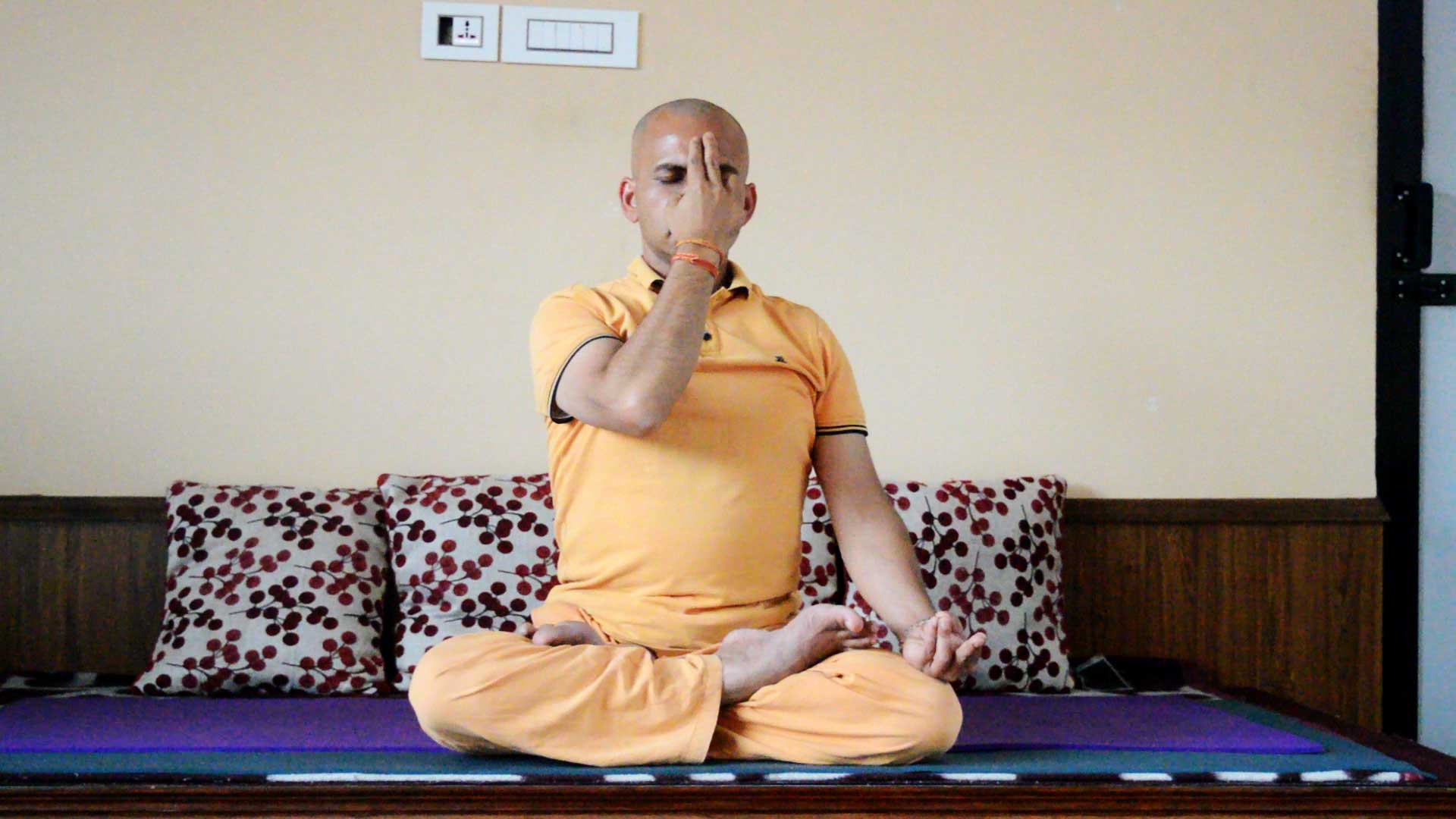
First find the breathing rate. Generally people have 16 breaths (one breath= one inhalation + one exhalation) per minute. Then counting 48 breaths is 3 minutes. With continuous Reiki practice, we have seen that the breaths become deeper and longer. So we request everyone to check the breathing rate after two weeks and then make the necessary adjustment. Then apply this method to change your habit.
Conclusion
Reiki healing is itself meditation, which is a divine process and a natural way where we can find our answers, and if you seek guidance to come about an issue we are currently facing in lives. When we are in a meditative state, the divine tries to communicate via messages and symbolism. In a deep meditative state, if we can request the guiding angels and divine souls to show us the path, they give us clues in different forms. It is the intensive inner path of meditation. Sometimes, we can also feel messages or ideas coming to us in different forms to support us.
Why Take Sankalpa (Resolve/Auto-Suggestion)?
INTRODUCTION
A Sankalpa may be a statement that does this for us. Literally, ‘San’ refers to reference to the very best truth ‘Kalpa’ means vow, or “the rule to be followed in particular other rules.”Sankalpa, then, may be a vow and commitment we make to support our highest truth. “By definition, a sankalpa should honor the deeper meaning of our life. Sankalpa is the key to Karma. The initiation of the day from Sankalpa will be perfect karma effects. A sankalpa speaks to the larger arc of our lives, our dharma—our overriding purpose for being here.” The Sankalpa becomes a press release you’ll call upon to remind you of your true nature and guide your choices.
An integral a part of yoga as transformation, as a way of making conscious change, starts with self inquiry and setting an intention. Each moment is the beautiful initiation of the beautiful day and each day is the beautiful initiation of this beautiful life. In yoga, we are invited to look inside and to make a Sankalpa – the only translation is ‘conscious intention’ or even ‘heart’s desire’ – it’s deeper than a press release of purpose; it’s an affirmation of who we are.
HOW TO DISCOVER YOUR SANKALPA
Discovering your sankalpa is a process of listening to yourself. Your heartfelt desire is already present, waiting to be seen, heard, and felt. It’s not something you need to make up, and the mind doesn’t have to go wildly searching for it. What do you want to do in life? That karma starts from today, right now, positively.
To research the heartfelt desire behind this type of intention, ask yourself what desire that behavior is currently trying to satisfy. Are you seeking good healing, peace of mind, freedom from pain, the sensation of being accepted, and the transformation of life? “See if you’ll find a deeper hunger, a longing that’s asking to be nourished. The sankalpa determines your way of life and conveys you to your goal.
USE MEDITATION TO LOOK INTO YOURSELF
Concentration and Meditation are the ways of practicing an individual self to train to the conscious mind state. It involves the way of position of body factor where one has to keep the state of the perfect set of mind and body in a one-way direction. The term meditation refers to the high broad sense of variety of practicing different techniques to conscious state of mind, body relaxation, build internal energy or life force exploration, and so on, and finally that brings you into silence or state of devoid.
When we practice self-inquiry (atma vichara), we give ourselves time to urge the basis of a story or limiting belief that we feature around – if we take time, we’d start to ascertain the origin of the story or even who we inherited that value or belief system from in our family.
LET’S CREATE A SANKALPA FOR A CHANGE
We must choose our own sankalpa very carefully. The wording should be very precise and clear, otherwise it will not penetrate the subconscious mind. The following are few short, positive, and clear statements which can be used for change.
Just for today, I will
Be Peaceful, happy, and honest.
Awaken my spiritual potential.
Be Kind; do love and respect to all.
Live by the attitude of gratitude.
Achieve total health.
Be more aware and efficient.
Be successful in all that I undertake.
CONCLUSION
We should our sankalpa according to our needs and inclinations. We should not be hurry and worry. Time I required depending on the nature of the resolve and the degree to which it is planted in the mind and heart. The result depends on our sincerity and deep felt need to attain the goal of our sankalpa. Sankalpa is the component in Prayer and Meditation as a major tool of Yoga.
Why Himalayan Yoga Academy Remained Open in Whole Lockdown Period?
Background
Himalayan Yoga Academy is a Yoga commune, not a Business Company. This international school is located in the countryside on the lap of the Jungle called Raniban (Queen of the Jungle) and the crown of New Town called Sunrise Height within Kathmandu city (City of temples) run by professionals. The only motto of this school, and owner too, is to facilitate the global people by fusing the ancient wisdom and modern technology. The owner informally began to put the step in Yoga and Tourism since 1997 and institutionally since 2007. His focus was to knock the global people from asleep sub-conscious minds and raise those who are innocently falling into ignorance of the ultimate reality of life and its phenomenon.
The Message
Since the beginning of the school, we have been working in lifestyle management by teaching the art of living throughout the biological clock of 24 hours i.e. 1440 minutes or 86400 seconds.
We always tried to provide the right message of yoga as a union of acts in a moment being aware, awake, and alert for sound health, purity, happiness, blissfulness in their life, and eventually keep free the people from sufferings.
Since the beginning of the programs, we have always talked about natural immunity as an original vaccine in the body. Himalayan Yoga Academy has always emphasized health management rather than disease management. We always talk about natural right, universal phenomenon, original rites and culture, sense of humor, and unconditional rules rather than unnatural, artificial, man-made things, conditionals.
The Fact
Viruses are creatures, microscopic organisms that always appear, bring hazards, and somehow disappear, so it is not the solution to scary, to escape, and to tense; it comes and goes that is natural. But our intelligence or our consciousness might be foresight that we have the permanent thing forever generation to generation until this species remain in this world that thing is our immunity, natural immune called original body vaccine.
- We have posted the covid-19 integrated tablets for prevention, remedies, healing, motivation, counseling through online and blog articles, videos, short notice and webinar presentation as well in social Medias and zoom online.
- Always informed and encouraged the people either to do yogic practices or to work hard in different fields, even farming, constructions, etc.
- We focused that everybody needs to break the sweat, enough cardio exercise, breath workout acts, hiking, trekking, climbing, etc.
- Practice of Yoganga during Covid-19.
- We have messaged them to do all yogic tools such as Nasal cleansing (Jala Neti), frontal brain cleansing (Kapalbhati ), Gargle and Rinsing, Jogging, physical Exercise, Yogasana, Breathing Acts, Pranayama, Yoga nidra, Meditation etc.
- We have also advised the people to apply natural and healthy food habits, herbal tea, natural spices, drinking water, enough sleep.
- Encouraged applying the laughing therapy, clapping therapy, Reiki Healing, etc.
- There were no any options except Yogic capsule. So we remained the school open and continued the classes to both Nepalese and foreigners.
- We are lucky because 2 to 3 persons of foreigners always were with us. Some of them stayed 27 days and some two months in Yoga Teacher Training 200 hours and 300 hours.
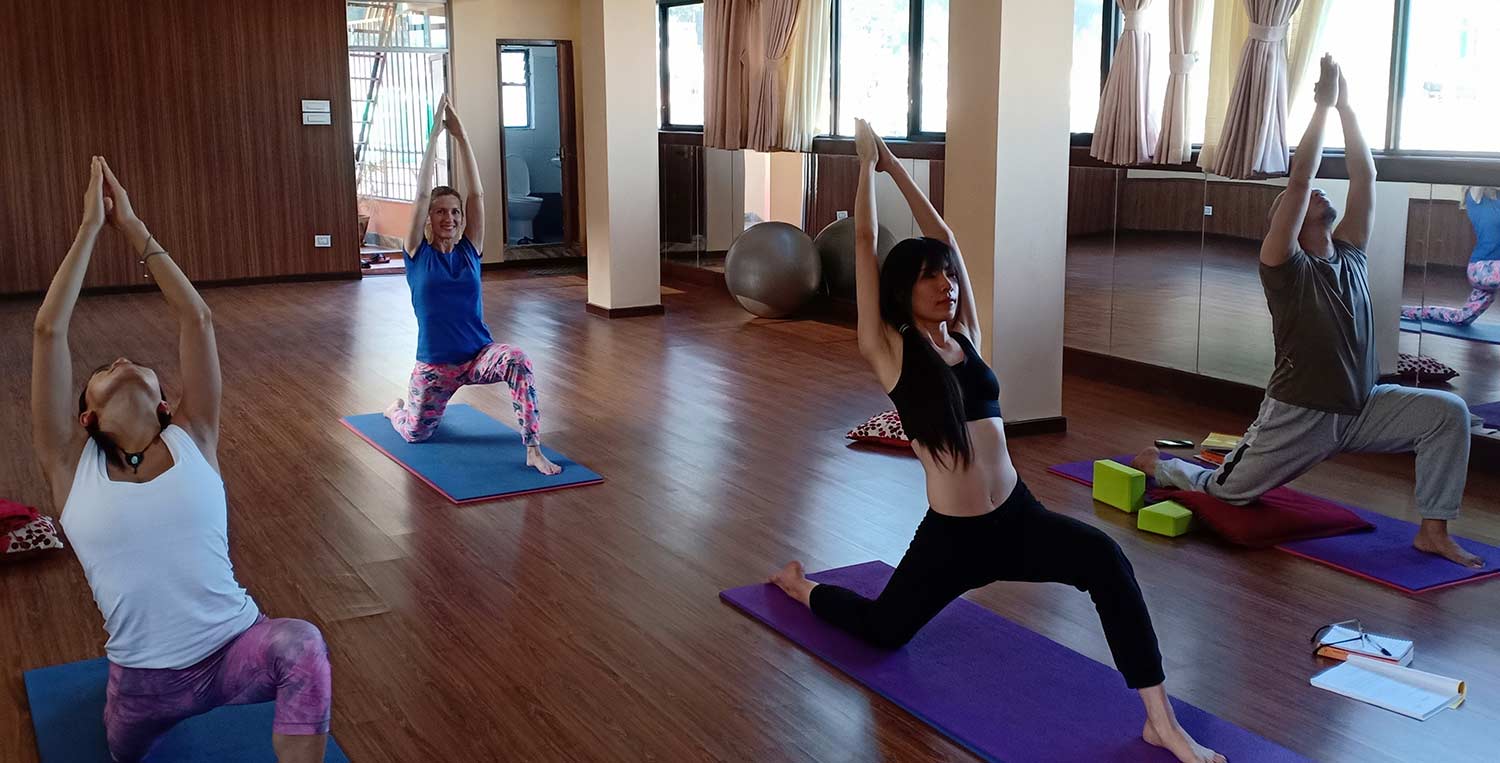
Conclusion
The pandemic situation started, and the lockdown began. People were locked up and stayed at home, slept in bed, watched television, saw the data of death and infected people, thought too much, got scared, torched mentally, and got worried about the situation, all these issues made them trouble that reduced and completely scaled down the immunity like battery down. So, viruses are temporary, but immunity is everything in life that is permanent, stays with us forever. Let’s recognize and boost and keep our generation safe and alive.
Why Learn Singing Bowl Training with Us?
Himalayan Yoga Academy is a Registered Yoga School certified as RYS 200, 300, & 500, affiliated to Yoga Alliance USA alongside a well-experienced professional team of teachers who are very keen to expand their knowledge into this world. Himalayan Yoga Academy provides a Singing Bowls Training Sound Healing Teacher Training Course. Why Learn Singing Bowl Training With Us? This course is based on a systemic syllabus and research pattern initiated for the first time at the Himalayan Yoga Academy in Nepal.
In this sound educational program, you’ll not only learn and practice the Natural Sound Meditation techniques we inherited from different cultures but also will understand the principles of Sound Healing. You’ll be trained in the art of leading various sorts of sound healing meditation sessions. Our Main Objective is to supply the core principles of Sound Healing and Meditation. Get the experience of practicing Sound Healing Meditations. Also, learn to use the knowledge to conduct Sound healing sessions and workshops.
Why Learn Singing Bowl Training with Us?
- You will learn how to play the various types of singing bowls that originated in Nepal. They were promoted in Tibet, Bharat, and around. How the different types of bowls have different benefits for the mind, body, and spirit.
- You will find out how to make sounds and vibrations in each of the Seven Chakras using the Tibetan Singing Bowls. For example, the Root Chakra keynote is C, and the frequency is 256 Hz. The Heart chakra’s keynote is F, with a frequency of 341.3 Hz.
- You will learn how to combine mantra sound Meditations with Tibetan Singing Bowls to give deep therapeutic healing sessions
- Professional Registered Singing Bowl Healers.
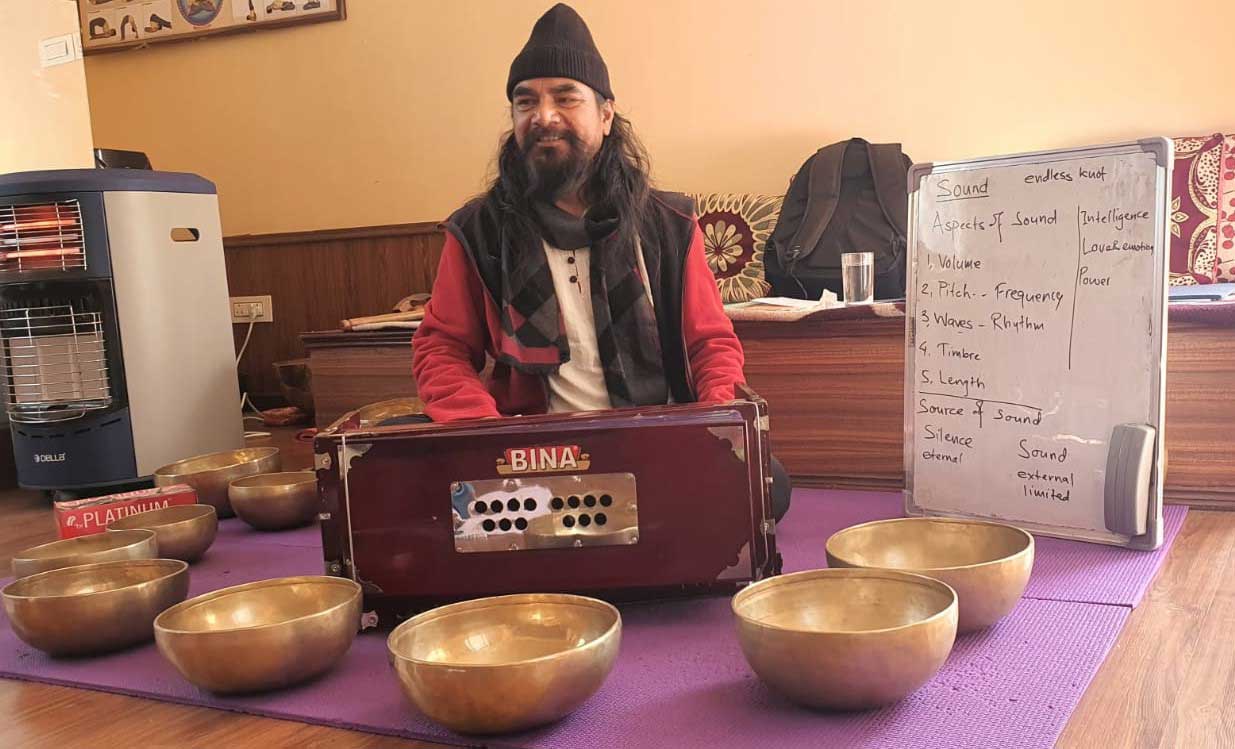
What to experience after our Singing Bowl Training?
- After our training, you will gain personal well-being, clarity, a positive attitude, and peace of mind.
- After Learn Singing Bowl Healing training, You will learn how to give 2-hour sessions of sound & vibration healing, using various techniques such as body contact and sound baths.
- Build a positive learning environment in which you and all other like-minded healers will thrive and create long-lasting friendships.
- You will learn how to work with both small and large groups making them more relaxed and receptive by combining sound healing meditation techniques in order to lead them into Group Sound Healing Concert.
- We have here music researchers and professors as resource persons at Himalayan Yoga Academy. All courses are designed and will be taught under their guidance.
How to Choose the Yoga Teacher Training that’s Aappropriate for You
Yoga as the transformation of Life
Yoga is the aim achieved from the regular practice of yogic means that can change lives. It helps, heals, transforms, and inspires people. Whether you are going to have on your mat for more days or months, the thought of becoming a certified yoga teacher trainer probably crosses your mind. With the massive value of people becoming certified yoga teachers, it’s no surprise that you’re curious about what it sorts of. If you’re looking to deepen your practice, learn more about yogic philosophy, understand more, experience more, or have a big interest in teaching others, choose the Yoga Teacher Training for you. Choosing a yoga teacher training program is an investment in yourself that yields lifelong transformation physically, mentally, emotionally, and spiritually. As such, the program you choose ultimately contributes to the direction of your growth.
Reasons for Choosing a Yoga Teacher Training in Nepal Program
Right now, you might not have a clear plan for teaching yoga. Take some time and think about what you’d like to do with your yoga instructor certification. As you planned, it’s a big investment of time, mind, and money. Of course! You should make sure you’re choosing the right program, right place, the right time, and right decision for you.
1. Mission of Life
What is the Mission of the program? It should be the mission of life to appear from mind and spirit, not only from the body’s needs.
2. Discipline of Programs
What should be the right discipline or faculty of life otherwise it does not meet your mission.
3. Yoga Alliance Approval and Certification
Is the program approved by Yoga Alliance or not? How do you become certified through the program in the journey from student to teacher? Yoga Alliance requires fundamental subject matters and hours. Is it valid worldwide or regional or only inner country?
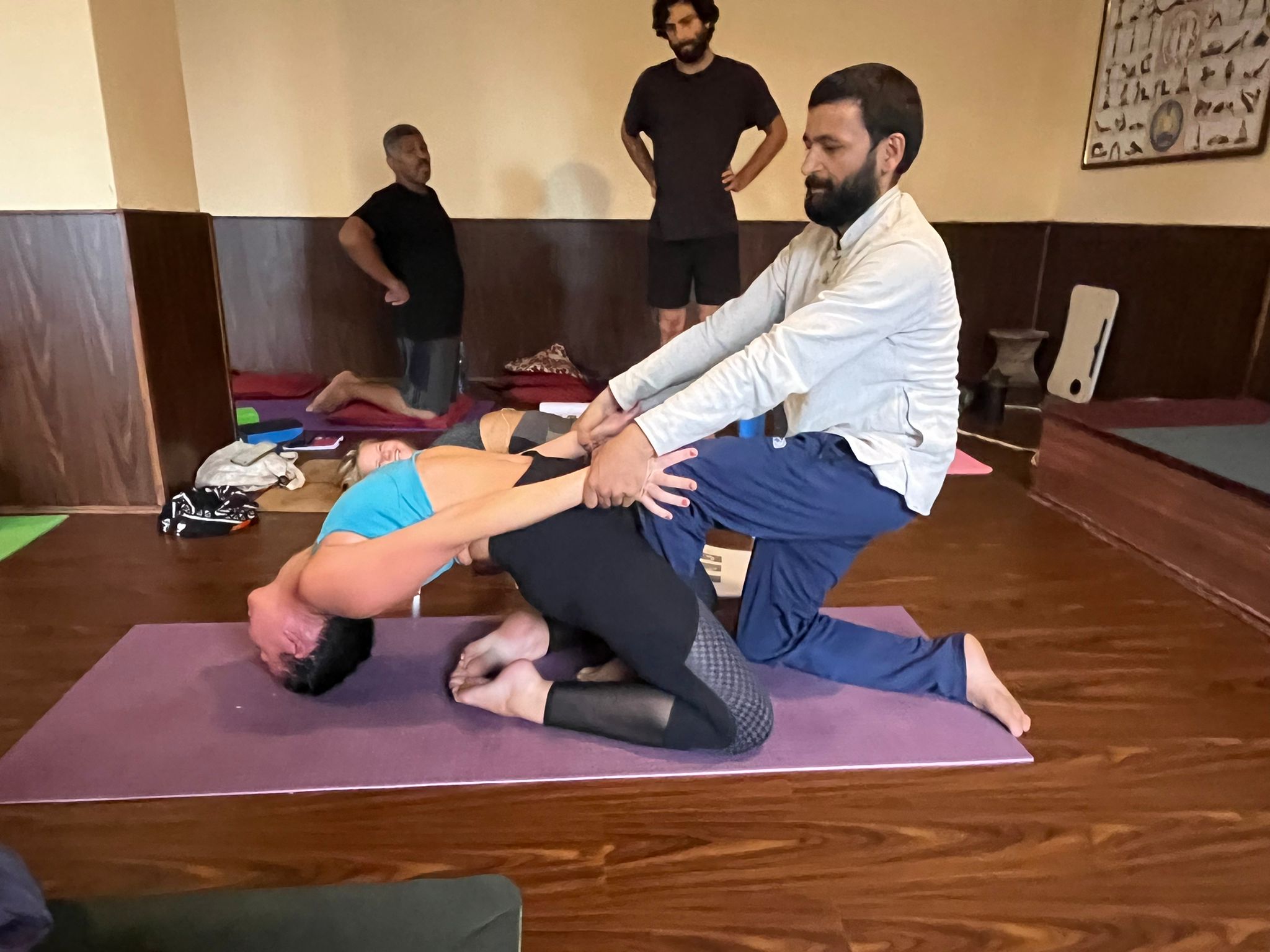
4. Lead Master
Yoga Alliance requires that each program has a designated lead trainer, and there may or may not be co-trainers. Who is the lead trainer? How long has the lead trainer been teaching yoga? He should teach the full hours mentioned by Alliance.
5. Location and Environment
Where is the location? What is the environment? It is very important for keeping the daily lifestyles better. Where you are, either in Nature close to the jungle, river, Himalayas, the beach or sea, hilly reason, open place, close to religious or historical venues, close to the village, ventilated hall and rooms, etc.
6. Learning and Teaching path
What foundations of learning and practice will be emphasized? What is the paradigm of teaching methodology? Is this both survival learning and experiential learning? Is it authoritarian or non-authoritarian and is it ethical and literal or just physical boosting?
7. Curriculum and Syllabus
Do the curriculum and syllabus fulfill the requirements that are set by Yoga Alliance? What emphasis is placed on the physical versus non-physical components of yoga? How is teaching proper alignment addressed? Is physical alignment taught in isolation, or are both physical and energetic alignment considered?
8. Self-Study and library facility and time
How does the yoga teacher training program teach you to deepen your self-awareness through conscious self-inquiry? How is this process facilitated by the school? It is very important to explore the self in formal, non-formal, or informal ways of learning.
9. Culture and society
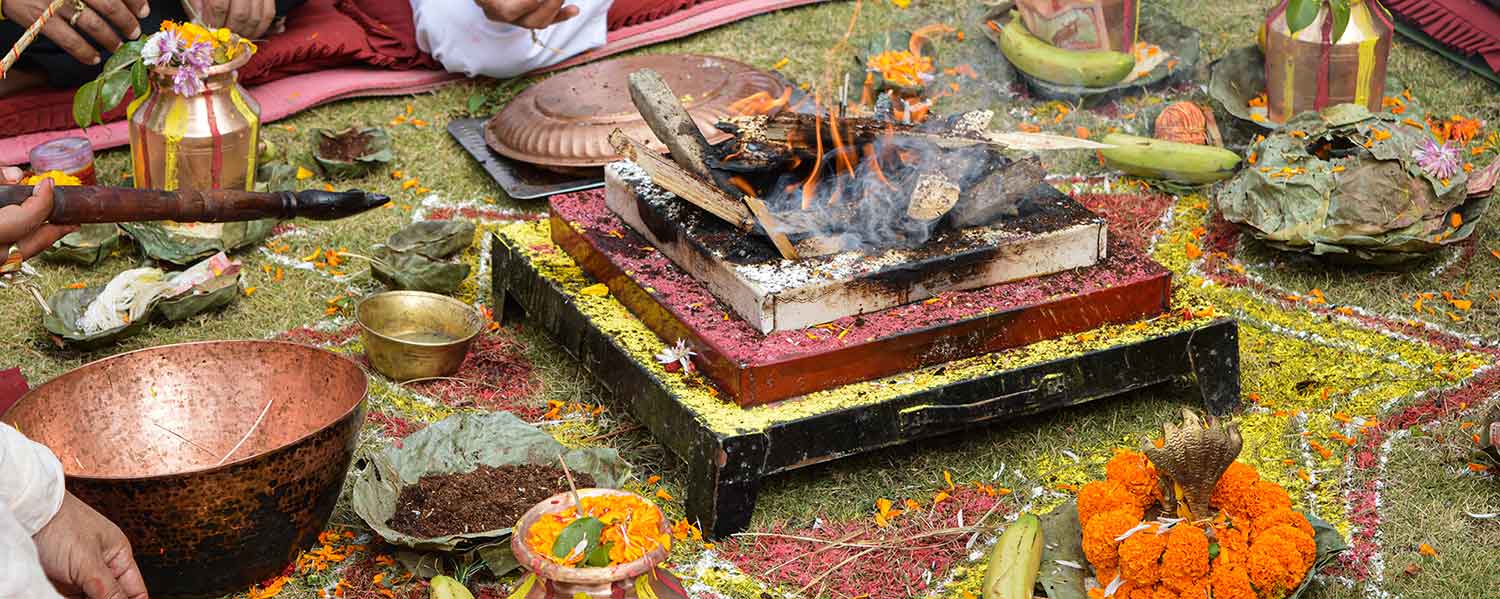
The training course should be in a safe space for its trainees and should get different cultural experiences. You should experience the typical lives and cultures.
10. Food and Accommodation facility
Food is divine. So it should be natural, vegetarian, vegan as the target group, and gluten-free as needed. Accommodation should be comfortable if possible private room, if not only two persons sharing one room.
11. Styles and Types of Yoga
You should choose traditional or ethical Yoga learning, not only one particular teacher’s style or sequence. Teacher style can meet just a small group of people in a small market. If you go into real yoga based on philosophical, physical, physiological, biological, psychological, and spiritual as well, it will be the right norms.
12. Methodology
The teaching methods should be multi-dimensional such as lecturing, discussing, demonstrating, presenting, observing, projecting, and practicum.
13. Cost of the Yoga Teacher Training
The yoga teacher training cost can vary in the place, facility, services, reputation, mission, and also depending on many factors such as on-site or off-site housing, meal plan, guest teachers, materials, special workshops, hiking, the business of yoga training, etc.
14. Contents of the Program
There are many types of yoga teacher training. If you’re researching a Yoga Alliance accredited school (a good idea), your training requirements will be broken down into the following categories: Techniques, Training, and Practice, Teaching Methodology, Anatomy & Physiology, Yoga Philosophy, Lifestyle and Ethics, Practicum, Remaining Contact and Elective Hours.
15. Eligibility
Everyone in the beginning is a beginner. So in general, very beginners can also join in Teacher Training courses. In general ages 10 to 100 old can join the courses. Even the disabled can also join the course if such a facility has been managed in school. Please you may join us with an open and free mind, not an occupied mind.
16. Ways of Teaching
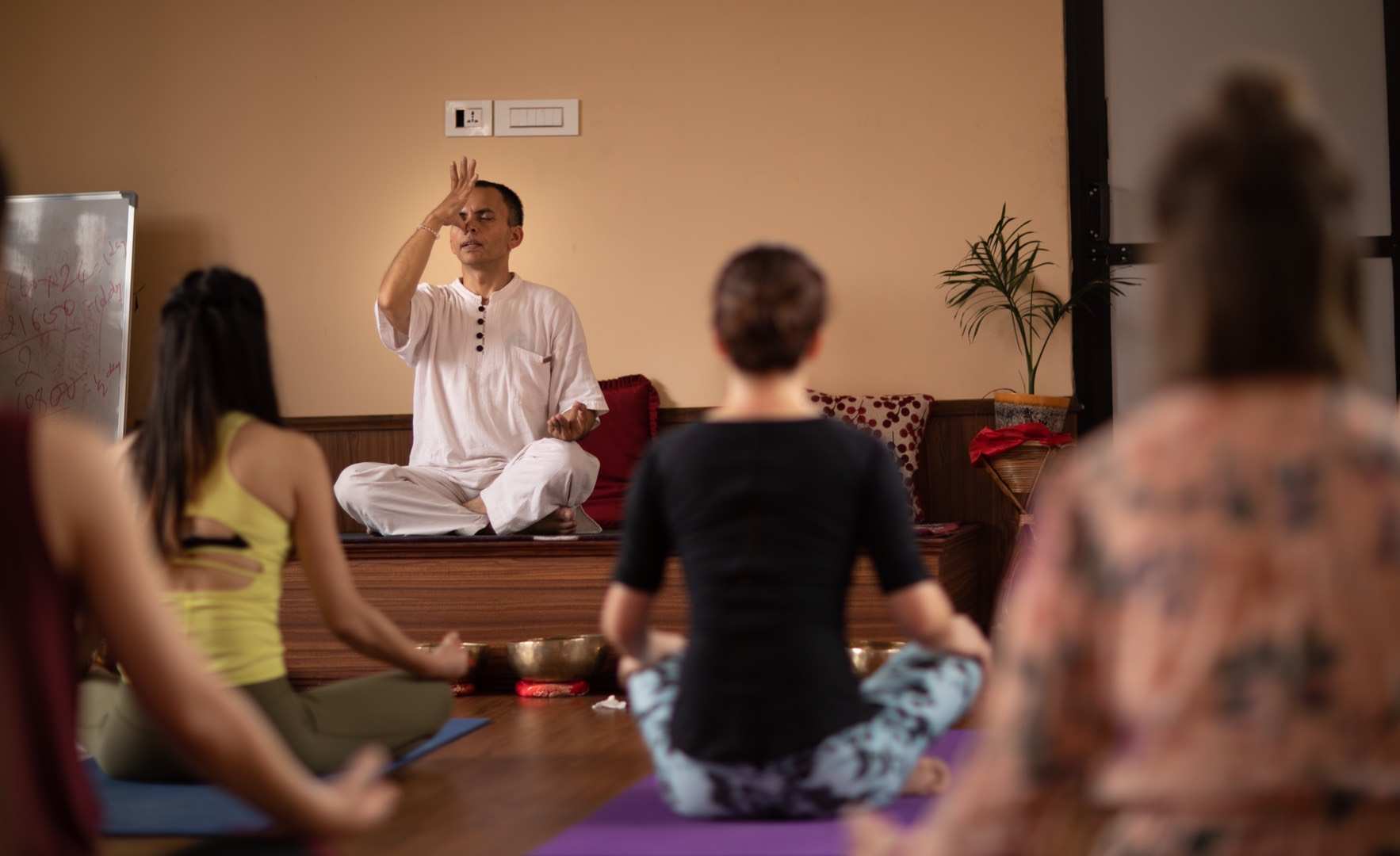
Learning should be formal, non-formal, and informal as the nature of yoga science. You should follow initiation, continuation, and Devotion.
17. Opportunity to learn yoga in the original place of Yoga, Himavat Khanda
Himalayan zones (Himavat Kshetra) is the country of the Himalayas called Nepal is the place where yoga was originally born. So when you go to Nepal and especially Bharat Khanda (South Asian Region), you will learn about yoga from its origin. The foundations of yoga are thought to date back to at least 15000 years ago in Himavat Kshetra by Adi Yogi Shiva. Knowledge of yoga first appeared in the Vedas, ancient philosophical texts from Bharat Khanda, and later in the Upanishads, the Bhagavad Gita, and Shata Darshana. Later, more extensive descriptions were recorded in the Samkhya Yoga and Yoga Sutras by Maharshi Kapil and Maharshi Patanjali, respectively.
18. Yogic lifestyle management
Following yoga teacher training in Nepal allows you to live a yogic lifestyle. Nepal is also the origin place of Ayurveda. The yogic lifestyle involves the acts of a biological clock of 24 hours, 140 minutes time figure, eating a balanced (Aahara), engaging in physical activity (Vihaara), positive thoughts (Vichaara), rest (Vishraama), and relaxation as well as sleep (Nidra).
19. High Altitude Practice
High altitude enriches your yogic practice and helps to awaken the kundalini power that expands our consciousness. The science behind is the effect of gravity.
Conclusion
There are lots of reasons why you should consider doing your yoga teacher training in the In Himavata Region, Nepal, with us. Nepal is the birthplace of Eastern wisdom like the Vedas and philosophies like Samkhya Yoga, Yoga Darshan, Mimansa, Bauddha Darshana, Bhagavad Geeta, Ramayana, and Ashtaavakra Geeta. Other advantages are the international character, the lower price, and the beautiful environment on the lap of the Himalayas. If you like, you can combine your training with Hiking, trekking, and traveling around the country-sides of the country. Altogether, it will be an experience of a lifetime that will probably leave a long-lasting positive impression on you. After your yoga teacher training in Nepal, you will go home with new true knowledge, insights, inspiration, experiences, happiness, and bliss that will heighten your life.
TRIKONASANA (TRIANGLE POSE)
The term Trikonasana त्रिकोणासन comes from the Sanskrit trikona, meaning “three corners” or “triangle,” and asana, meaning “posture.” The term is often used synonymously with utthita trikonasana (extended triangle pose).
Trikonasana is a standing yoga posture that requires strength, balance, and flexibility. In this posture, both arms extend with the legs spread apart and one foot turned at a 90-degree angle. The upper body bends toward the lead foot so that one arm reaches toward, but not necessarily touching, the ground and the other toward the sky.
Methods
- Stand straight. Separate your feet comfortably wide apart (about 3 to 4 feet).
- Turn your right foot out 90 degrees and left foot in by 15 degrees.
- Now align the center of your right heel with the center of your arch of left foot.
- Ensure that your feet are pressing the ground and the weight of your body is equally balanced on both the feet.
- Inhale deeply and as you exhale, bend your body to the right, downward from the hips, keeping the waist straight, allowing your left hand to come up in the air while your right hand comes down towards floor. Keep both arms in straight line.
- Rest your right hand on your shin, ankle, or the floor outside your right foot, whatever is possible without distorting the sides of the waist. Stretch your left arm toward the ceiling, in line with the tops of your shoulders. Keep your head in a neutral position or turn it to the left, eyes gazing softly at the left palm.
- Ascertain that your body is bent sideways and not backward or forward. Pelvis and chest are wide open.
- Stretch maximum and be steady. Keep taking in long deep breaths. With each exhalation, relax the body more and more. Just be with the body and the breath.
- As you inhale, come up, bring your arms down to your sides, and straighten your feet.
- Repeat the same on the other side.
Variations of Trikonasana
- Sarala Trikonasana
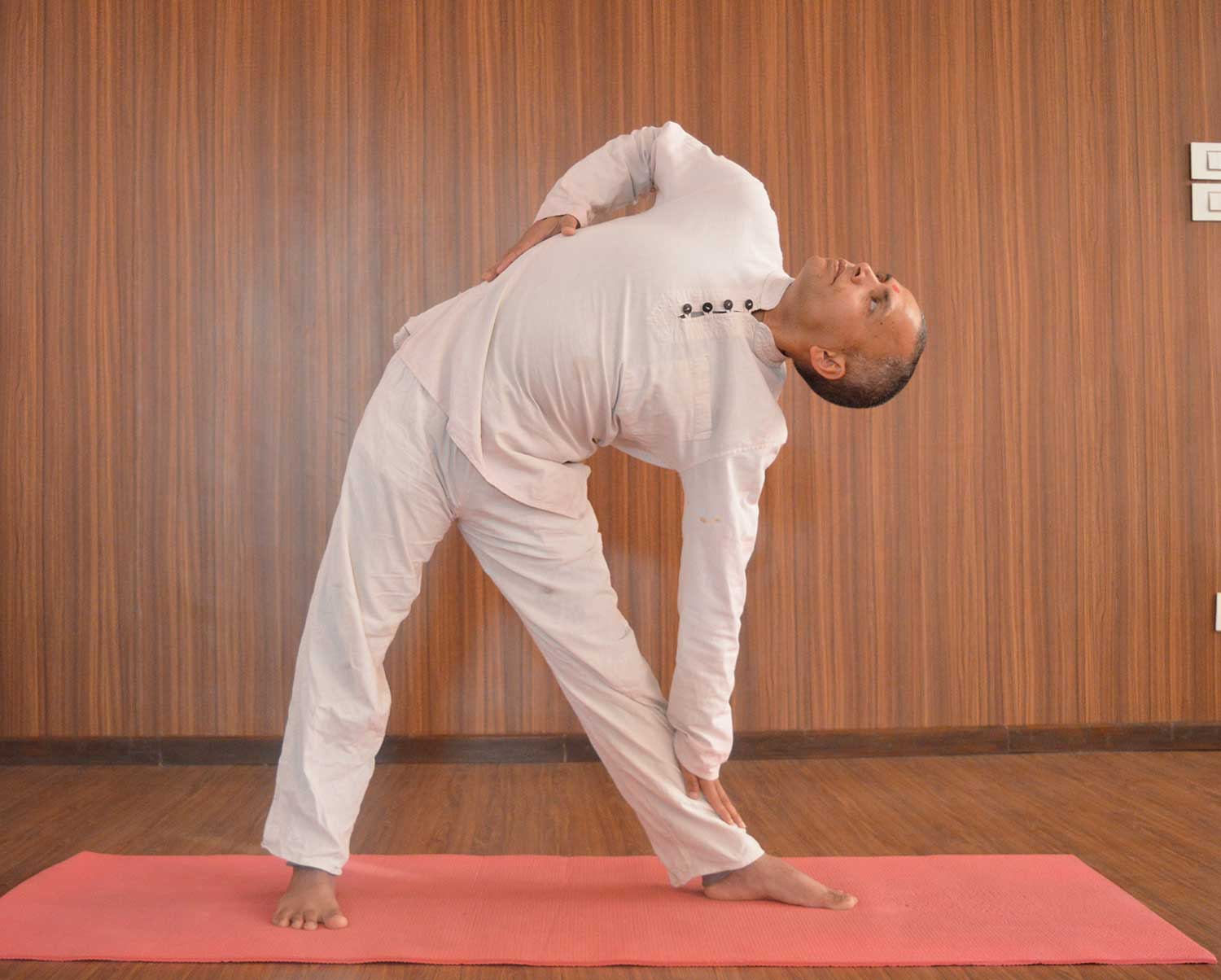
2. Trikonasana
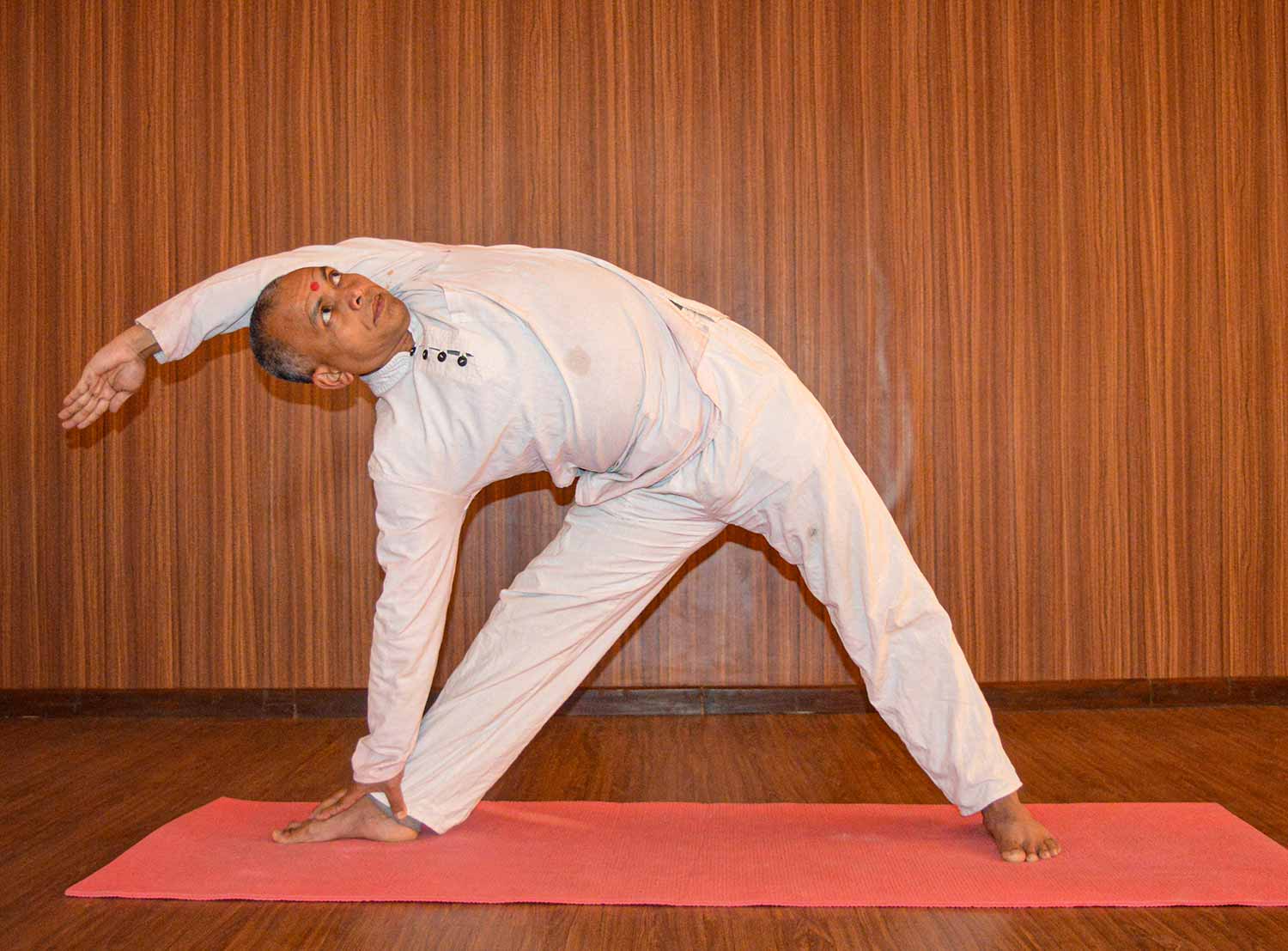
a. Utthita Trikonasana
b. Parivrtta Trikonasana
a. Utthita Trikonasana
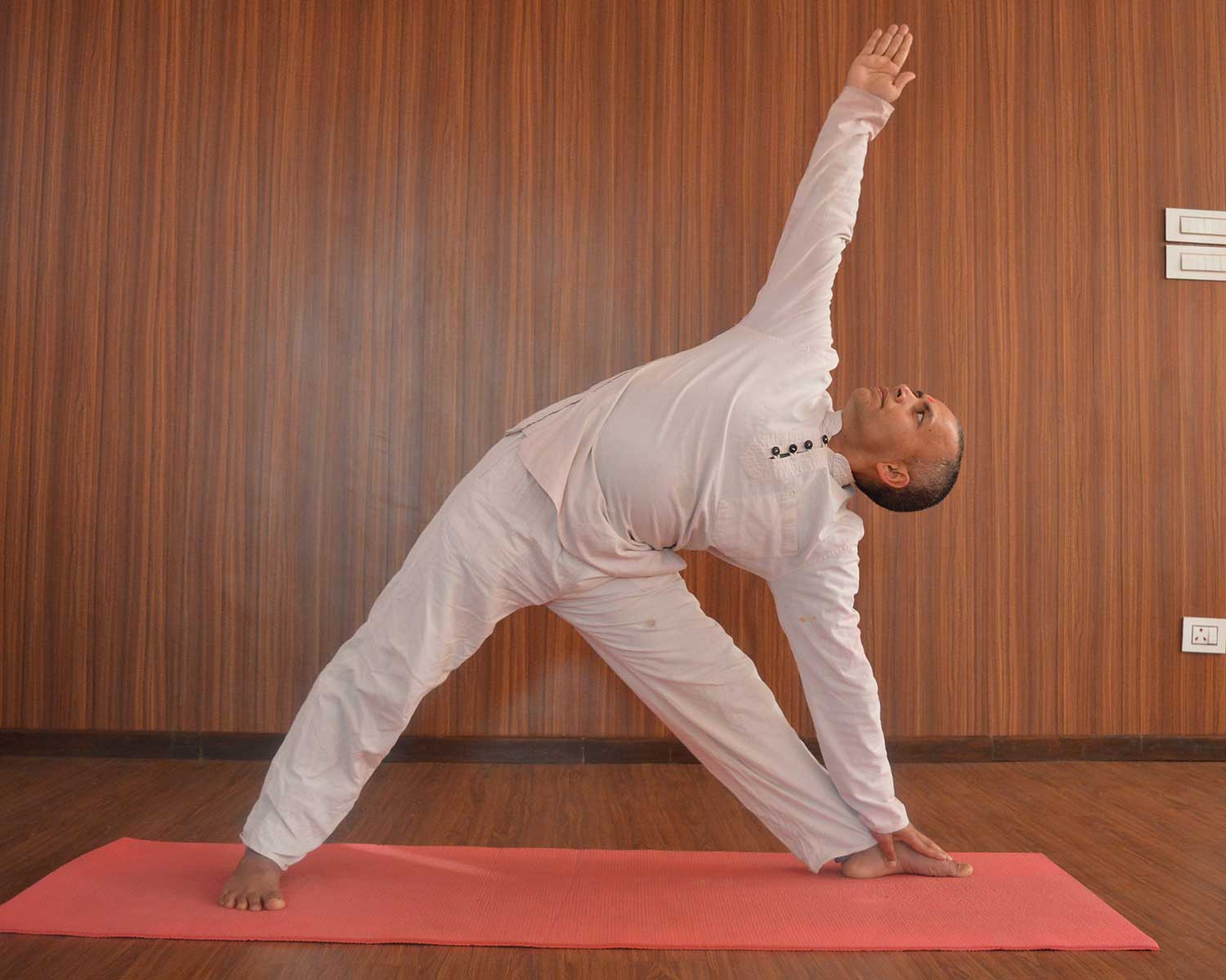
The name Utthita Trikonasana उत्थित त्रिकोणासन; comes from the Sanskrit utthita, meaning “extended,” trikona, meaning “three corners” or “triangle,” and asana, meaning “pose.” People often use the term synonymously with trikonasana (triangle pose). The common English name for Utthita Trikonasana is Extended Triangle Pose.
Uttihita trikonasana is a standing yoga asana that requires balance and flexibility. In this posture, straight legs are spread apart and one foot is at a 90-degree angle. With both arms extended, the body bends toward the lead foot so that one arm reaches toward the ground and the other toward the sky. In addition to a range of physical benefits, uttihita trikonasana is believed to stimulate energy pathways in the body.
b. Parivrtta Trikonasana
Parivrtta Trikonasana is an Asana Yoga pose. It is translated as Revolved Triangle Pose from Sanskrit, the name of this pose comes from parivrtta meaning revolved, tri meaning three, kona meaning angle, and asana meaning posture or seat. This pose is a variation of Trikonasana or Triangle Pose.
Technique of Parivrtta Trikonasana
- Stand in Tadasana (or mountain pose), i.e. feet together, toes touching and hands by your side.
- Exhale and jump with your feet, 3-4 feet apart.
- Raise your arms parallel to the mat. They should be in the line with your shoulder and be facing down.
- Turn your right foot 90 degrees to the right & left foot 45 degrees to your right.
- Make sure your left and right heels are aligned and turn your right thigh outward.

- Slowly turn to your right, exhale and bend down in front of your right leg and touch the floor with your left hand.
- Inhale and raise your right arm up towards the ceiling. You can even use the “yoga -block” for the support, if you are unable to touch the floor.
- Turn your head up and look at the thumb of the raised hand.
- Make sure your neck is in a comfortable position.
Benefits of Practicing Trikonasana
- This exercise helps to strengthen and stretches the legs.
- It stretches the hip and spine and increases flexibility.
- This exercise expands the chest and shoulders and removes the stiffness of neck and Beneficial in correcting the misalignment of the shouldersStrengthens the legs, knees, ankles, arms and chestStretches and opens the hips, groins, hamstrings, calves, shoulders, chest and spineIncreases mental and physical equilibriumIt stretches spinal muscles and increases the spinal range of motion.
- This exercise helps to increases neck mobility.
- It helps the body to inhale fresh oxygen and nutrients and helps improve digestion
- Revitalize abdominal organs hence helpful in getting rid of digestive problems and constipation.
- It Strengthens and tones the muscles of the thighs, back pain and sciatica
- Stretches calf muscles, thigh, hamstrings and hip muscles
- It improves the sense of balance by keeping the feet and ankles in space.
- Massages reproductive organs and pelvic region of the body.
- Gives an intense stretch to the spine and enhances its flexibility.
- Strengthens spinal nerves and it helps to relieve upper back tension and reduces anxiety, and stress.
- Directs the blood flow in the lower region of the spine improving its functioning
Preparatory asanas to do before Trikonasana
- Tadasana
- Triyak Tadasana
- Katichakrasana
- Konasana
- Vrikshasana
Precautions
- If you have a spine or back injury then you are advised to do this yoga asana under the expert supervision of an experienced yoga teacher.
- Students with problems like migraine, low blood pressure, headache, diarrhoea should also avoid doing this yoga asana.
Learn these poses with our experienced teachers at Himalayan Yoga Academy, our academy provides 200 hour & 300 Hour Yoga Teacher Training Courses, as RYT200 Yoga Certification offers detailed teachings on asanas (Yoga Postures), meditation, Pranayama, yoga philosophy, yoga anatomy physiology, alignment-adjustment, teaching methodology as well as fundamentals of Ayurveda and its importance. Our experienced teachers of Yoga School, like Swami Yog Subodh, will surely guide your path with different knowledge and skills.
PRANAYAMA AND SHATKARMA: HATHA PRADEEPIKA
Introduction
Instruction from a proper Guru is of paramount importance to the practice of Pranayama. Shatkarma (Svatmarama) explains how disturbance in the mind may be related to disturbances in the breath and how learning to restrain the latter may bring about greater steadiness of the mind. As long as the vital air (5 pranas) operates within the body, there is life. When they cease to, there is death. A restraint of the breath is therefore necessary to gain a greater experience of that which lies beyond and is free from the effect of the senses.
The practice of Pranayama is geared towards purifying the Nadis – all the nerve patterns – so that the Prana can ultimately pass through the Sushumna, the middle channel, and then awaken the practitioner to his/her true identity – which is beyond name and form. The first method listed is alternate nostril breathing. This is gradually supplemented with the practice of Kumbhakas (retentions), but caution is given so the practitioner does bring about his ruin:
“Yathaa sinho gajo vyaaghro Bhaved Vasyah shanaih shanaih !
Tathaiva sevito vayurnyathaa hanti saadhakam !!2.15!!
“Just as lions, elephants, and tigers are controlled by degrees, similarly the breath is to be controlled gradually, and otherwise it may kill the practitioner. By the proper practice of Pranayama, all disease is eradicated, but an improper practice gives rise to all sorts of disease.” (2.15-16)
Great care should therefore be taken when one engages in Pranayama practice. First and foremost a good grounding in the practice of postures is expected. To awaken the more subtle patterns of the breath Shatkarma (Svatmarama) optionally suggests that Six Karmas.
* be performed for the removal of phlegm, constipation, and the general sluggishness that cause disturbance to the mind and nervous system. These are:
“Dhautirvastistathaa Netistratakam Naulikam tathaa !
kapalabhaatishchaitaani shatakarmarmaani prachakshate !! 2.22
6 Karmas (Shat Karmas)
1. Dhauti
2. Basti
3. Neti
4. Trataka
5. Nauli
6. Kapalabhati
“Suryabhedanmujjaayee seetkaaree sheetalee tathaa !
Bhastrikaa Bhramari moorchchhaa plaavineetyashtakumbhakaah !! 2.44
*However, some Acharyas (teachers) claim Pranayama practice in itself is sufficient to cleanse the body of its impurities (2.37).
The main purpose of Pranayama is to:
1) rid the practitioner of the fear of death
2) to purify the Nadis
3) to cause the breath to enter the Sushumna.
The state of Manonmani – steadiness of mind – is then brought about. The accomplishment of this may be brought about by the practice of Retention (Khumbhakas). These Khumbhakas are to be practiced together with the 3 bandhas. Eight kinds of Khumbhaka are listed:
Khumbhakas:
1. Surya Bhedana
2. Ujjayi
3. Sitkari
4. Shitali
5. Bhastrika
6. Bhramari
7. Murcha
8. Plavini.
The highest essence of Pranayama practice is known as Kevala Kumbhaka: a complete and spontaneous cessation of breath where no effort of inhalation or exhalation is needed. This is only mastered by the most capable yogis and gives a direct experience of Raja Yoga.
In this chapter, we are also reminded that Hatha Yoga and Raja Yoga are mutually dependent on each other in order to bring about the highest result. No success can be attained in either without the proper practice of both.
HATHA PRADIPIKA FIRST CHAPTER
Hatha Pradipika is one of the foremost texts on Hatha Yoga. It is divided into five chapters, covering Asana, Pranayama, Mudra, Samadhi, and Yoga therapy. The author of the Hatha Pradipika First Chapter text is Swatmarama. This name may be allegorical: Swatmarama means “one who delights in his Self/Atman”. Thus, the reader may wonder if the writer changed his name to mention the true advantages of Yoga or if it was a name he was given after realizing the greatest merits of Yoga.
“Shreeaadinaathaaya Namo’stu tasmai yenopadishtaa hathayogavidhaa !
Vibhraajate Pronnataraajayogamaarodhumichchhoradhrohiniv !!1.1
An important feature of the text is that Hatha Yoga and Raja Yoga are not considered separate entities. One of a physical nature and the other spiritual, but rather an integrated whole, both dependent upon each other for the essence of Yoga to be realized. Raja Yoga is mere theory unless embodied and practically understood whilst the practice of Hatha Yoga is fixed in the corporal sphere unless a deeper integration of spirit is infused into it. When the mind is finally exhausted from its identification with Knowledge and knowable objects, the atman – the soul – is all that remains. Then, there is no longer any duality in the working mind, and the soul may shine through in its unobstructed essence.
“Hathaviddhya param gopyaa yoginaa siddhimichchhataa !
Bhaved veeryavatee guptaa nirveeryaa tu prakaashitaa !! 1.11
There is some speculation as to whether Swatmarama actually had a deeper experience of his topic or whether he was merely a hired scribe compiling a system. However, Yoga was traditionally conveyed through a lineage from teacher to student. Some of the more obscure passages are in keeping with the tradition of preserving the secrecy of the true meaning of Yoga (1.11). This tradition may perhaps have evolved to preserve the potency of the practice in a world of triviality.
Chapter 1: Injunctions on how to perform Asanas
Certain principles are given for the successful outcome of the practice of Asanas. After describing the proper place of practice, the author then advises us on 6 negative and 6 positive behaviors which each respectively diminish or cultivate greater success in Yoga.
6 causes that make a yoga practice futile are (1.15):
1. Over-eating
2. Over-exertion
3. Talking too much
4. Severe austerities
5. Public contact
6. Fickleness of mind
The 6 that bring speedy success are (1.16)
1. Enthusiasm
2. Courage
3. Perseverance
4. Proper understanding
5. Determination
6. Avoiding excessive contact with people
Here, as well as in many other Yoga texts, it is a 6-limb practice that begins with Asana. The stress is placed on cultivation of practical exercises, but the Yamas and Niyamas are not be abolished altogether: they act as a grounding influence to make the mind receptive to Yoga within the postures. Some manuscripts of HYP include Yamas and Niyamas, whilst others do not. In copies that do, these (Yamas and Niyamas) are each 10 in number:
Yamas (1.17)
1. Ahimsa
2. Truth
3. Non-stealing
4. Continence
5. Forgiveness
6. Endurancec
7. Compassion
8. Meekness
9. Sparing diet
10. Cleanliness
Niyamas (1.18)
1. Tapas
2. Patience
3. Belief in God
4. Charity
5. Adoration of God
6. Hearing discourses on the doctrine of religion
7. Shame
8. Intellect
9. Japa
10. Yajna
All manuscripts do agree upon the purpose of Asanas: “It is the first limb of Hatha Yoga and Asanas are therefore described first. I should be practiced for steadiness of posture, health and lightness of body” (1.17 or 1.19, depending on the edition). The rich traditions of postures originating from the sages are merely referred to, and only 15 are mentioned in total. Four of them are considered to be the most important ones, namely, Siddhasana, Padmasana, Simhasana, and Bhadrasana (1.36).
A clear description is given for all the postures mentioned, along with respective benefits.
In addition, the author also suggests that they should be complemented with the practice of Mudras for proper cleansing of the Nadis to take place. Close attention to Nada is also suggested, together with proper observation of food patterns and curbing the senses in general. In short, food is to be taken moderately. It should be well cooked, supplemented with ghee and sweets, and always offered up to the Lord Shiva. Food that may be disturbing to the practice is described as bitter, sour, salty, or hot. Also mentioned are too many green vegetables, sour gruel oil, mustard, and sesame. Consumption of alcohol, fish, meat, yoghurt, buttermilk, plums, oil-cakes, asafetida, garlic, onion, etc., are also said to be bad for the Hatha Yogi (1.61).
